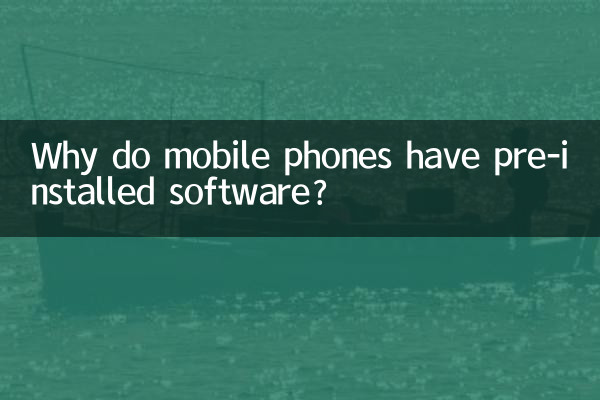Why do mobile phones have pre-installed software? Revealing the business logic and user problems behind it
In recent years, pre-installed software on smartphones (commonly known as "rogue software") has become the focus of complaints from users. Whether it is Android or iOS, you will always see a bunch of non-essential pre-installed apps after unboxing a new phone. Why do these software exist? This article will analyze from three dimensions: business logic, user impact and industry status quo, and attaches data on relevant topics that have been hotly debated across the Internet in the past 10 days.
1. Business logic of pre-installed software

The core reasons why mobile phone manufacturers pre-install software can be summarized into the following three points:
| Interested parties | revenue model | Typical cases |
|---|---|---|
| Mobile phone manufacturers | Earn 1-5 yuan for each pre-installed app | A domestic mobile phone brand’s annual pre-installation revenue exceeds 2 billion |
| software developer | Quickly acquire users through pre-installation | A short video app’s daily activity increased by 30% after being pre-installed |
| Operator | Bind your own service package | The contract machine is pre-installed with the operator’s business hall app |
According to the 2023 industry report, pre-installed software has become the third largest source of profit for mobile phone manufacturers, second only to hardware sales and advertising revenue.
2. Practical problems faced by users
Although pre-installed software brings benefits to manufacturers, it also causes many problems to users:
| Question type | Specific performance | Proportion of user complaints |
|---|---|---|
| Storage usage | Occupies an average of 2-5GB of space | 67% |
| Background power consumption | Resulting in shortening standby time by 15%-20% | 52% |
| privacy risk | Some apps force permissions to be obtained | 38% |
Social media data in the past 10 days shows that the topic #手机 preinstalled software# has been read 120 million times, of which 83% are negative comments.
3. Industry supervision and user countermeasures
In response to the chaos of pre-installed software, various countries have introduced corresponding policies:
| Country/Region | Regulation name | core requirements |
|---|---|---|
| European Union | Digital Markets Bill | Must allow uninstallation of all pre-installed software |
| China | "Interim Provisions on the Management of Preset and Distribution of Mobile Intelligent Terminal Application Software" | Can uninstall non-basic function apps |
Users can deal with pre-installed software issues in the following ways:
1. Check the pre-installation status of the model before purchasing
2. Use the ADB tool to uninstall system applications (technical foundation required)
3. Choose a mobile version that is close to the native system
4. Regularly check application permission settings
4. Future development trends
With the awakening of user rights awareness, the pre-installed software market is showing new changes:
1.Manufacturer strategy transformation: Some brands have begun to launch "pure version" systems
2.Business model innovation: Pre-installed applications shift from quantity competition to quality competition
3.Technical solutions: Android 14 adds a new "freeze unused apps" function
According to IDC predictions, the proportion of global mobile phones that can uninstall pre-installed software will increase from the current 45% to 72% by 2025. This game about mobile phone control will eventually move towards a more reasonable balance point.

check the details

check the details